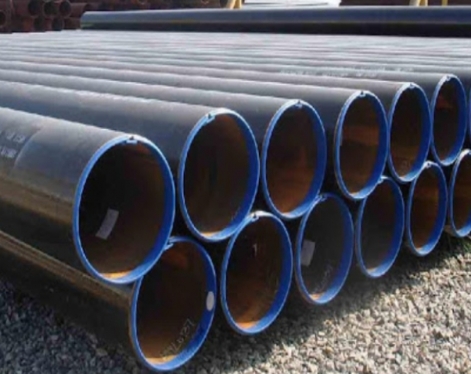The forming methods for manufacturing large-diameter LSA steel pipes include UOE forming method, roll forming method (CFE), CE forming and so on. For most of the forming methods, the last process is to perform a full-length expansion of the welded tube blank to improve the quality of the welded tube. Diameter expansion has become an important process in the production of large-diameter straight seam steel pipes to ensure the quality of finished pipes.
Diameter expansion is a pressure processing technology that uses hydraulic or mechanical means to apply force from the inner wall of the steel pipe to expand the steel pipe radially outward. The mechanical method is simpler and more efficient than the hydraulic method. Several of the world’s most advanced large-diameter straight-seam steel pipe pipelines have been used for the expansion process.
The process is:the mechanical expansion utilizes the split sector block at the end of the expander to expand in the radial direction, so that the tube blank is stepped along the length direction to realize the plastic deformation process of the entire tube length in sections.
Divided into 5 stages:
1. The preliminary rounding stage. The fan-shaped block is opened until all the fan-shaped blocks touch the inner wall of the steel pipe. At this time, the radius of each point in the inner tube of the steel pipe within the step length is almost the same, and the steel pipe is initially round.
2. Nominal diameter stage. The fan-shaped block starts to reduce the movement speed from the front position until it reaches the required position, which is the inner circumferential position of the finished pipe required by the quality.
3. Rebound compensation stage. The fan-shaped block will further slow down at the position of stage 2 until it reaches the required position, which is the position of the inner circumference of the steel pipe before rebound as required by the process design.
4. Pressure holding and stable stage. The sector block remains stationary for a period of time before rebounding on the inner circumference of the steel pipe. This is the pressure holding and stable stage required by the equipment and the diameter expansion process.
5. Unloading and returning stage. The sector block rapidly retracts from the inner circumference of the steel pipe before rebounding, until it reaches the initial expansion position, which is the smallest contraction diameter of the sector block required by the diameter expansion process.
In practical applications, in the process simplification, the 2 and 3 steps can be combined and simplified, which has no effect on the expansion quality of the steel pipe.
Diameter expansion is a pressure processing technology that uses hydraulic or mechanical means to apply force from the inner wall of the steel pipe to expand the steel pipe radially outward. The mechanical method is simpler and more efficient than the hydraulic method. Several of the world’s most advanced large-diameter straight-seam steel pipe pipelines have been used for the expansion process.
The process is:the mechanical expansion utilizes the split sector block at the end of the expander to expand in the radial direction, so that the tube blank is stepped along the length direction to realize the plastic deformation process of the entire tube length in sections.
Divided into 5 stages:
1. The preliminary rounding stage. The fan-shaped block is opened until all the fan-shaped blocks touch the inner wall of the steel pipe. At this time, the radius of each point in the inner tube of the steel pipe within the step length is almost the same, and the steel pipe is initially round.
2. Nominal diameter stage. The fan-shaped block starts to reduce the movement speed from the front position until it reaches the required position, which is the inner circumferential position of the finished pipe required by the quality.
3. Rebound compensation stage. The fan-shaped block will further slow down at the position of stage 2 until it reaches the required position, which is the position of the inner circumference of the steel pipe before rebound as required by the process design.
4. Pressure holding and stable stage. The sector block remains stationary for a period of time before rebounding on the inner circumference of the steel pipe. This is the pressure holding and stable stage required by the equipment and the diameter expansion process.
5. Unloading and returning stage. The sector block rapidly retracts from the inner circumference of the steel pipe before rebounding, until it reaches the initial expansion position, which is the smallest contraction diameter of the sector block required by the diameter expansion process.
In practical applications, in the process simplification, the 2 and 3 steps can be combined and simplified, which has no effect on the expansion quality of the steel pipe.









